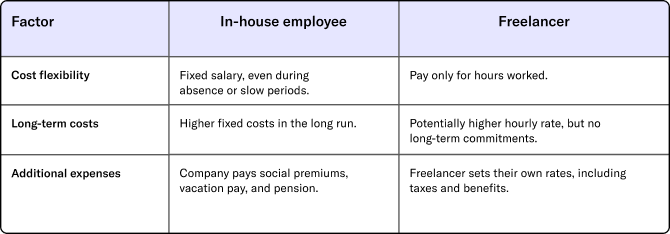
Recruiting an employee is an important and well-considered decision. It goes beyond the salary and involves total worker costs and obligations that come with permanent workers. At the same time, many companies benefit from flexibility. Seasonal demand, market trends, and economic conditions can change quickly, affecting workforce needs. Freelancers can be an attractive option to scale up without long-term contracts or high costs.
In this article, we discuss the costs of employing workers, what to consider, and why combining in-house employees with flexible professionals can be the ideal solution.
The cost structure of an employee
Hiring an employee involves more costs than just the salary. In addition to gross wages, there are various additional expenses that determine the total cost for a business. The business costs of a worker consist of:
- Gross salary
The minimum wage of an employeeis legally regulated and depends on the worker’s age. The minimum salary may be higher if your sector falls under a collective labor agreement (CLA). Many CLAs include agreements about the minimum salary you must offer—often higher than the legal minimum wage. Additionally, a competitive salary and secondary benefits may be necessary to attract candidates in a competitive job market.
- Vacation pay
In addition to the salary, every employee is entitled to vacation pay, which amounts to 8% of the gross annual salary.
- Worker insurance contributions
Businesses pay premiums for employee insurance such as unemployment insurance (WW), disability insurance (WAO/WIA), and sickness benefits. These premiums vary by sector and company.
- Income-dependent health insurance contribution
Businesses also pay an income-dependent contribution under the Health Insurance Act (Zvw).
How much an employee costs a business often depends on these mandatory contributions, which can significantly increase total labor expenses.
Hidden costs of in-house employees
We now know that salary accounts for approximately 75% of total employment costs and that numerous additional expenses exist. However, recruiting a new employee involves more than just salary and standard costs. There are many hidden, direct, and indirect costs that can add up quickly:
1. Recruitment costs
Posting job vacancies, recruiter fees, job fairs, and conducting interviews all require time and money. Considering the average cost to recruit a worker can help you budget accurately.
2. Administrative costs
Background checks, paperwork, payroll setup, and enrollment in benefits programs all generate costs. Onboarding and training can also be significant expenses.
3. Ongoing costs
Beyond salary, you also cover bonuses, insurance, licenses, work attire, travel expenses, company cars, and more.
4. Absenteeism costs
For long-term absence, businesses must continue paying wages for up to two years, even for temporary or zero-hour contracts.
5. Termination costs
Laying off employees comes with severance payments and administrative burdens, even for temporary employment contracts.
6. Legal and compliance costs
Labor law compliance is complex and time-consuming. If worker classifications don’t meet legal standards, businesses may face additional compliance costs and reputational challenges. Smaller companies sometimes need extra support or guidance to stay compliant with evolving regulations.
Scaling up without hidden costs
Recruiting in-house employees may be your first thought when scaling up, but there are multiple ways to grow your workforce and meet changing demand, market trends, or economic conditions without the risks and extra costs of long-term employment contracts.
Consider an on-demand flexible work platform that allows you to quickly find freelance professionals for shifts when needed. These professionals bring fresh energy to your company, possess specialized knowledge, and can elevate your team’s performance. Additionally:
- They are flexible, meaning you only pay for hours worked.
- You avoid extra costs for social security premiums or vacation pay- since they’re taking care of it themselves.
- You are not responsible for continued payment during sick leave.
Business cost for a worker often decreases when you can scale up or down without committing to full-time salaries and additional overhead.
Where to find reliable freelancers?
With Temper, the digital marketplace for freelance professionals, you can easily post shifts and select qualified professionals that match your organisation. Since they work as freelancers, they manage their own administration and payments. Additionally, all professionals working via Temper are covered for liability, accidents, and sick leave.
If you seek continuity, you can even invite them to your flexpool, giving them first access to new shifts. This allows you to build a trusted group of go-to freelancers. Below, we compare the costs of permanent workers versus a freelancer via Temper.
Key differences between in-house employees and freelancers

Read more about freelancer costs here.
Conclusion
Many businesses benefit from flexibility. Seasonal demand, market trends, and economic conditions can change quickly, affecting workforce needs. Worker costs extend beyond wages; they also include taxes, insurance, absenteeism risk, and overhead. By considering these factors, you get a clearer picture of the true cost of a professional.
Permanent workers come with fixed structures that may not always align with your needs. Freelancers offer a flexible, low-risk way to scale up without long-term contracts or high expenses. For companies wondering how much a worker costs a business overall, factoring in these indirect costs is crucial.
With Temper, the digital job board for businesses and freelancers, you gain the flexibility to quickly adapt to changing conditions. Our platform provides access to a pool of experienced freelancers who can seamlessly integrate with your existing team and workflows.
Need to scale up for a busy weekend? Post extra shifts on our platform and find qualified workers within 90 minutes. Facing an unexpected slowdown? Cancel shifts without notice periods or pay obligations.







.webp)
